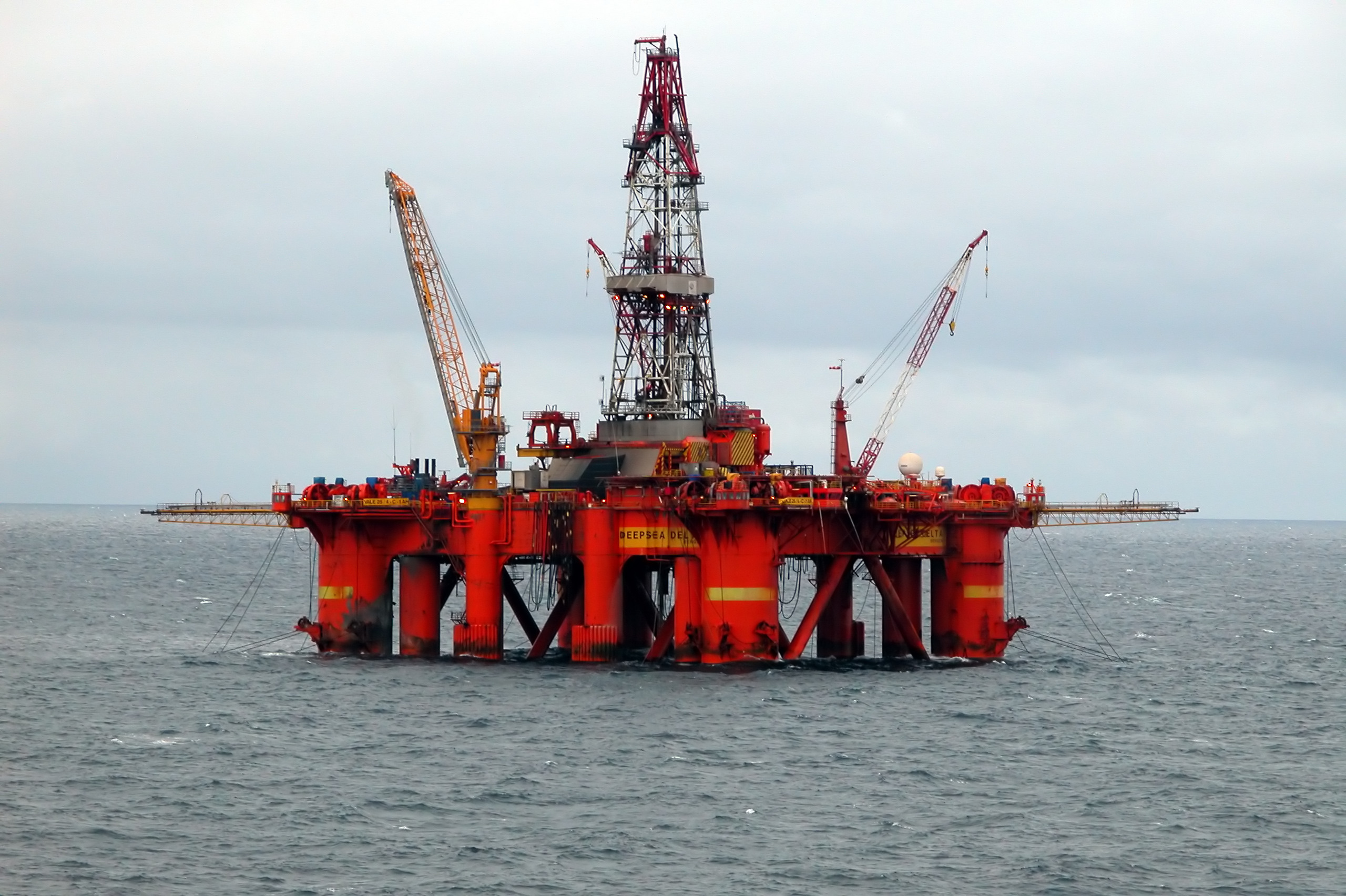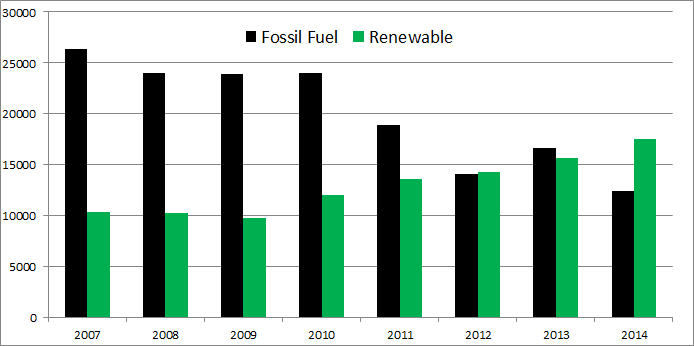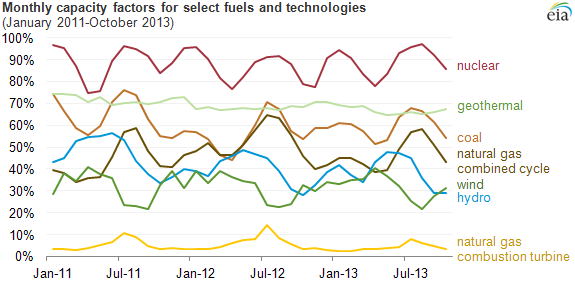|
Solar Power In Denmark
Solar power in Denmark is at 2,339 MW (grid-connected) by mid-2022, and contributes to a goal to use 100% renewable energy by 2050. The goal of 200 MW of photovoltaics by 2020 was reached eight years early, in 2012, and 36 MW was being installed each month. Denmark had 790 MW in late 2015. A total of 3,400 MW is expected to be installed by 2030. Many solar-thermal district heating plants exist and are planned in Denmark. Installed capacity Timeline Solar power provided 1.4 TWh, or the equivalent of 4.3% or 3.6% of Danish electricity consumption in 2021. In 2018, the number was 2.8 percent. Denmark has lower solar insolation than many countries closer to Equator, but lower temperatures increase production. Modern solar cells decrease production by 0.25% per year. 2020 In 2020 The Danish Energy Agency announced 400 MW PV projects in the Nissum Fjord location. 2015 In 2015 only 6.3 MW was applied for out of a funding pool of 41 MW. The funding is valued at 1.02 DKK ... [...More Info...] [...Related Items...] OR: [Wikipedia] [Google] [Baidu] |
MegaWatt
The watt (symbol: W) is the unit of Power (physics), power or radiant flux in the International System of Units, International System of Units (SI), equal to 1 joule per second or 1 kg⋅m2⋅s−3. It is used to quantification (science), quantify the rate of Energy transformation, energy transfer. The watt is named after James Watt (1736–1819), an 18th-century Scottish people, Scottish invention, inventor, mechanical engineer, and chemist who improved the Newcomen steam engine, Newcomen engine with his own Watt steam engine, steam engine in 1776. Watt's invention was fundamental for the Industrial Revolution. Overview When an object's velocity is held constant at one metre per second against a constant opposing force of one Newton (unit), newton, the rate at which Work (physics), work is done is one watt. : \mathrm In terms of electromagnetism, one watt is the rate at which electrical work is performed when a current of one ampere (A) flows across an electrical potentia ... [...More Info...] [...Related Items...] OR: [Wikipedia] [Google] [Baidu] |
Energy In Denmark
Denmark has considerable sources of oil and natural gas in the North Sea and ranked as number 32 in the world among net exporters of crude oil in 2008. Denmark expects to be self-sufficient with oil until 2050.Unforeseen billions from North Sea ''Maritime'', 4 December 2011. Accessed: 8 December 2011. However, gas resources are expected to decline, and production may decline below consumption in 2020, making imports necessary.Andersen, Christian Meiniche Gas supply 2011-2013 page 17 '' |
Biofuel In Denmark
Biofuels play a major part in the renewable energy strategy of Denmark. Denmark is using biofuel to achieve its target of using 100% renewable energy for all energy uses by 2050. Biofuels provide a large share of energy sources in Denmark when considering all sectors of energy demand. In conjunction with Denmark's highly developed renewable energy resources in other areas, biofuels are helping Denmark meet its ambitious renewable energy targets. The main sources of biofuels in Denmark include wood and wood products, energy from waste, straw, biogas, biodiesel and bioethanol. Biofuels have the potential to provide environmental and economic benefits but they must be carefully managed to ensure that they are truly sustainable resources. There is the potential for economic and environmental damage if biofuels are not used responsibly. Biofuel use in Europe must be certified by the EU commission before biofuels can be recorded as sustainable resources and used for national renewable ene ... [...More Info...] [...Related Items...] OR: [Wikipedia] [Google] [Baidu] |
Wind Power In Denmark
Denmark was a pioneer in developing commercial wind power during the 1970s, and today a substantial share of the wind turbines around the world are produced by List of wind turbine manufacturers, Danish manufacturers such as Vestas—the world's largest wind-turbine manufacturer—along with many component suppliers. In Electricity sector in Denmark, Denmark's electricity sector wind power produced the equivalent of 47% of Denmark's total electricity consumption in 2019, an increase from 43.4% in 2017, 39% in 2014,Rasmussen, Jesper Nørskov.Vindmøller slog rekord i 2014" (in Danish) ''Energinet.dk'', 6 January 2015. Accessed: 6 January 2015. and 33% in 2013.Carsten Vittrup.2013 was a record-setting year for Danish wind power" (in Danish) ''Energinet.dk'', 15 January 2014. Accessed: 20 January 2014. In 2012, the Danish government adopted a plan to increase the share of electricity production from wind to 50% by 2020, and to 84% by 2035.Lindboe, page 3 Denmark had the 4th best ener ... [...More Info...] [...Related Items...] OR: [Wikipedia] [Google] [Baidu] |
Renewable Energy In Denmark
Denmark is a leading country in wind energy production and wind turbine production. Wind power alone produced 47% of Denmark's electricity consumption in 2017, and is expected to increase its production by nearly 80% in the years to 2024. Denmark had a target of producing 30% of all its energy needs from renewable energy sources by 2020, a considerable increase from the 17% it attained in 2005; in 2017 this figure reached the goal, with 32.7% of observed energy consumption coming from renewable energy sources. The country has ambitious renewable energy goals for the future, including using renewable energy for 100% of its energy needs in all sectors by 2050. In the heating sector the country has long used and continues to develop district heating (DH) networks. Hot water or steam is produced centrally and then distributed through a network of insulated pipes to high population areas. Houses within a district heating area have heat exchangers installed instead of boilers for thei ... [...More Info...] [...Related Items...] OR: [Wikipedia] [Google] [Baidu] |
Solar Power By Country
Many countries and territories have installed significant solar power capacity into their electrical grids to supplement or provide an alternative to conventional energy sources. Solar power plants use one of two technologies: * Photovoltaic (PV) systems use solar panels, either on rooftops or in ground-mounted solar farms, converting sunlight directly into electric power. * Concentrated solar power (CSP, also known as "concentrated solar thermal") plants use solar thermal energy to make steam, that is thereafter converted into electricity by a turbine. Worldwide growth of photovoltaics is extremely dynamic and varies strongly by country. By the end of 2019, a cumulative amount of 629 GW of solar power was installed throughout the world. By early 2020, the leading country for solar power was China with 208 GW, accounting for one-third of global installed solar capacity. As of 2020, there are at least 37 countries around the world with a cumulative PV capacity of more than o ... [...More Info...] [...Related Items...] OR: [Wikipedia] [Google] [Baidu] |
Heat Pump
A heat pump is a device that can heat a building (or part of a building) by transferring thermal energy from the outside using a refrigeration cycle. Many heat pumps can also operate in the opposite direction, cooling the building by removing heat from the enclosed space and rejecting it outside. Units that only provide cooling are called air conditioners. When in heating mode, a refrigerant at outside temperature is being compressed. As a result, the refrigerant becomes hot. This thermal energy can be transferred to an indoor unit. After being moved outdoors again, the refrigerant is decompressed — evaporated. It has lost some of its thermal energy and returns colder than the environment. It can now take up the surrounding energy from the air or from the ground before the process repeats. Compressors, fans, and pumps run with electric energy. Common types are air-source heat pumps, ground-source heat pumps, water-source heat pumps and exhaust air heat pumps. They are al ... [...More Info...] [...Related Items...] OR: [Wikipedia] [Google] [Baidu] |
Seasonal Thermal Energy Storage
Seasonal thermal energy storage (STES), also known as inter-seasonal thermal energy storage, is the storage of heat or cold for periods of up to several months. The thermal energy can be collected whenever it is available and be used whenever needed, such as in the opposing season. For example, heat from solar collectors or waste heat from air conditioning equipment can be gathered in hot months for space heating use when needed, including during winter months. Waste heat from industrial process can similarly be stored and be used much later or the natural cold of winter air can be stored for summertime air conditioning. STES stores can serve district heating systems, as well as single buildings or complexes. Among seasonal storages used for heating, the design peak annual temperatures generally are in the range of , and the temperature difference occurring in the storage over the course of a year can be several tens of degrees. Some systems use a heat pump to help charge and dis ... [...More Info...] [...Related Items...] OR: [Wikipedia] [Google] [Baidu] |
Marstal
Marstal () is a town in southern Denmark, located in Ærø Municipality on the island of Ærø. Marstal has a population of 2,120 (1 January 2022)BY3: Population 1. January by rural and urban areas, area and population density The Mobile Statbank from Statistics Denmark and is the largest town on Ærø. It was the municipal seat of the now abolished Marstal Municipality. Marstal has a long maritime history. For centuries Marstal vessels have sailed the seven seas, and even today the town is the home port for a considerable number of coasters. Shipping is still the nerve of the town with its dockyards, its shipping companies and its maritime school which for more than a century has trained navigators for the Danish merchant fleet. Marstal is the economic center of Ærø and ... [...More Info...] [...Related Items...] OR: [Wikipedia] [Google] [Baidu] |
Hectare
The hectare (; SI symbol: ha) is a non-SI metric unit of area equal to a square with 100-metre sides (1 hm2), or 10,000 m2, and is primarily used in the measurement of land. There are 100 hectares in one square kilometre. An acre is about and one hectare contains about . In 1795, when the metric system was introduced, the ''are'' was defined as 100 square metres, or one square decametre, and the hectare ("hecto-" + "are") was thus 100 ''ares'' or km2 (10,000 square metres). When the metric system was further rationalised in 1960, resulting in the International System of Units (), the ''are'' was not included as a recognised unit. The hectare, however, remains as a non-SI unit accepted for use with the SI and whose use is "expected to continue indefinitely". Though the dekare/decare daa (1,000 m2) and are (100 m2) are not officially "accepted for use", they are still used in some contexts. Description The hectare (), although not a unit of SI, i ... [...More Info...] [...Related Items...] OR: [Wikipedia] [Google] [Baidu] |
Capacity Factor
The net capacity factor is the unitless ratio of actual electrical energy output over a given period of time to the theoretical maximum electrical energy output over that period. The theoretical maximum energy output of a given installation is defined as that due to its continuous operation at full nameplate capacity over the relevant period. The capacity factor can be calculated for any electricity producing installation, such as a fuel consuming power plant or one using renewable energy, such as wind or the sun. The average capacity factor can also be defined for any class of such installations, and can be used to compare different types of electricity production. The actual energy output during that period and the capacity factor vary greatly depending on a range of factors. The capacity factor can never exceed the availability factor, or uptime during the period. Uptime can be reduced due to, for example, reliability issues and maintenance, scheduled or unscheduled. Other fact ... [...More Info...] [...Related Items...] OR: [Wikipedia] [Google] [Baidu] |







